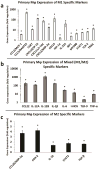Melanoma exosomes promote mixed M1 and M2 macrophage polarization
- PMID: 29459345
- PMCID: PMC5857255
- DOI: 10.1016/j.cyto.2018.02.002
Melanoma exosomes promote mixed M1 and M2 macrophage polarization
Abstract
Macrophages are key participants in melanoma growth and survival. In general, macrophages can be classified as M1 or M2 activation phenotypes. Increasing evidence demonstrates that melanoma exosomes also facilitate tumor survival and metastasis. However, the role of melanoma exosomes in directly influencing macrophage function is poorly understood. Herein, we investigated the hypothesis that natural melanoma exosomes might directly influence macrophage polarization. To explore this hypothesis, ELISA, RT-qPCR, and macrophage functional studies were performed in vitro using an established source of melanoma exosomes (B16-F10). ELISA results for melanoma exosome induction of common M1 and M2 cytokines in RAW 264.7 macrophages, revealed that melanoma exosomes do not polarize macrophages exclusively in the M1 or M2 direction. Melanoma exosomes induced the M1 and M2 representative cytokines TNF-α and IL-10 respectively. Further assessment, using an RT-qPCR array with RAW 264.7 and primary macrophages, confirmed and extended the ELISA findings. Upregulation of markers common to both M1 and M2 polarization phenotypes included CCL22, IL-12B, IL-1β, IL-6, i-NOS, and TNF-α. The M2 cytokine TGF-β was upregulated in primary but not RAW 264.7 macrophages. Pro-tumor functions have been attributed to each of these markers. Macrophage functional assays demonstrated a trend toward increased i-NOS (M1) to arginase (M2) activity. Collectively, the results provide the first evidence that melanoma exosomes can induce a mixed M1 and M2 pro-tumor macrophage activation phenotype.
Keywords: Chemokine; Cytokine; Exosomes; M1/M2; Macrophage; Melanoma; Polarization.
Copyright © 2018 The Authors. Published by Elsevier Ltd.. All rights reserved.
Conflict of interest statement
Figures





References
-
- Witwer KW, Buzas EI, Bemis LT, Bora A, Lasser C, Lotvall J, Nolte-'t Hoen EN, Piper MG, Sivaraman S, Skog J, Thery C, Wauben MH, Hochberg F. Standardization of sample collection, isolation and analysis methods in extracellular vesicle research. Journal of extracellular vesicles. 2013;2 - PMC - PubMed
-
- Hood JL. The association of exosomes with lymph nodes. Seminars in cell & developmental biology. 2017;67:29–38. - PubMed
-
- Peinado H, Aleckovic M, Lavotshkin S, Matei I, Costa-Silva B, Moreno-Bueno G, Hergueta-Redondo M, Williams C, Garcia-Santos G, Ghajar C, Nitadori-Hoshino A, Hoffman C, Badal K, Garcia BA, Callahan MK, Yuan J, Martins VR, Skog J, Kaplan RN, Brady MS, Wolchok JD, Chapman PB, Kang Y, Bromberg J, Lyden D. Melanoma exosomes educate bone marrow progenitor cells toward a pro-metastatic phenotype through MET. Nature medicine. 2012;18(6):883–91. - PMC - PubMed
Publication types
MeSH terms
Substances
Grants and funding
LinkOut - more resources
Full Text Sources
Other Literature Sources
Miscellaneous

